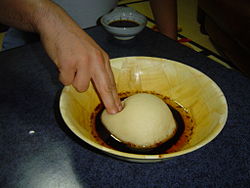Asida

|
|
| Type | Pudding |
|---|---|
| Region or state | Middle East, North Africa |
| Main ingredients | wheat flour, butter or honey |
| |
|
Asida (Arabic: عصيدة ‘aṣīdah) is a dish made up of a cooked wheat flour lump of dough, sometimes with added butter or honey. Similar to gruel or porridge, it is eaten in many North African countries. It is particularly popular in Algeria, Libya, Tunisia, Eritrea, and Sudan. It is usually eaten by hand, without the use of utensils. Often served during religious holidays such as Mawlid and Eid, it is also served during traditional ceremonies accompanying the birth of child, such as the ‘aqīqah, the cutting of the hair of a newborn seven days after birth.
A simple yet rich dish, often eaten without other complementary dishes, it is traditionally served at breakfast and is also fed to women in labor.
One of the earliest documented recipes for asida is found in an anonymously authored Hispano-Muslim cookbook dating to the 13th century. In the 13th and 14th centuries, in the mountainous region of the Rif along the Mediterranean coast of Morocco, a flour made from lightly grilled barley was used in place of wheat flour. A recipe for asida that adds argan seed oil was documented by Leo Africanus (c. 1465-1550), the Arab explorer known as Hasan al-Wazan in the Arab world.
The Libyan variation of asida is served with a sweet syrup, usually date or carob syrup (rub), but also with honey.
The Tunisian version of this dish are either served with a mixture of honey and butter, or tomato-based hot sauce. The latter is more common later in the day and the former earlier. Assida is also commonly consumed with date syrup in southern parts of Tunisia.
...
Wikipedia
